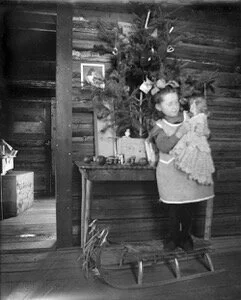Christmas on the Frontier - Indian Territory
Christmas in Oklahoma can be traced back to the 1800’s when people started to leave the sanctuary of their eastern homes to settle in the remote territory of Indian Territory (I.T.). Like many of the people who migrated to the American West, pioneers who settled in I.T. brought with them cultural traditions long practiced in the communities they left behind. But, by its nature, the frontier environment they found often altered many ways in which these pioneers celebrated Christmas. These new frontier residents most often came together to celebrate their first Christmases by sharing traditions and inventing new practices, which created many of the same Christmas customs we enjoy in Oklahoma today.
Some of the first Christmas celebrations recorded in Oklahoma were among members of the Five Civilized Tribes in Indian Territory (I.T.). Before the federal government forcibly removed the Cherokees, Chickasaws, Choctaws, Creeks and Seminoles from their eastern homeland during the 1830’s, missionaries worked among the tribes to convert them to Christianity. After settlement in Indian Territory of present-day eastern Oklahoma, missionaries continued working to build missions and schools to serve the Native people. One missionary, Henry Wilson, was sent to Indian Territory by the Presbyterian Missionary Board.
When Wilson arrived at the Dwight Mission, I.T., on a cold December evening of 1832, he was delighted to hear the mission bells ringing. His travelling companions told him that the bells were calling the converted Cherokees to service and that they were preparing for the Christmas celebration. During his long travels, Wilson had wondered what Christmas would be like in the West.
Later, he would write about his first Christmas in I.T. experience by noting, “When I entered the mission church, they were singing hymns in the Cherokee language. Never before did music appear half so sweet to me; the language is music itself.” After spending Christmas among 100 Cherokee families who had gathered, Wilson recorded that “this was the happiest Christmas I ever spent, though far from home and friends and destitute of the luxuries and comforts to which I have become accustomed.”
Settlers to the West, came together as family to celebrate Christmas because in many cases their new friends took the place of family. The celebrations usually took place in the local school or church. The planning began weeks ahead with a check list that somewhat resembles ours today: locating and chopping down the tree, decorating the tree, preparing for the Christmas program, finding someone to play Santa Claus, make and distribute gifts and coordinate the community Christmas dinner. In this way, Christmas helped the new settlers to adjust to their homes away from home.
Finding a tree in the more arid regions of the Territory was a challenge. The Eastern custom emphasized the traditional pine Christmas tree. In Oklahoma Territory (O.T.) and I.T., a native oak or blackjack tree had to be substituted. The challenge was to turn this tree into a pine laden with snow. To accomplish this, the children wrapped the tree limbs and twigs with cotton. After the tree had its traditional “wintry look”, the children proceeded to decorate it with strings of popcorn and berry garlands. Candles were used for lights.
Food has always been a very important part of Christmas memories and traditions. Food and condiments we take for granted today were considered specialties, such as oranges and spices such as gloves and cinnamon. The aroma of these ingredients flowed through the homes and churches as the dinner was being prepared. The fruits and vegetables used for the Christmas dinner were canned, preserved and pickled during the summer months. Because of the abundance of game in the area, dinner also included bear meat, buffalo tongue, venison, prairie hen, wild turkey, goose, duck, quail and pigeon.
Government agents and missionaries who lived among the different Plains Tribes in Oklahoma also introduced Christmas and holiday customs of the nineteenth-century America to the Native people. Along with teaching the religious significance of Christmas, missionaries introduced the practice of gift giving.
The culture of modern-day Oklahoma has been enriched with the customs of the Eastern Europeans who immigrated to Indian Territory before statehood in 1907. The Czechoslovakians, in particular, left their mark in cities like Prague, Yukon, Wheatland, Perry and in parts of Oklahoma City. They brought Christmas traditions from old Bohemia, where the holiday dinner consisted of roast goose, which was filled with sauerkraut and bread dumplings.
Because of the migration of culturally diverse people who chose to travel to one of the last frontiers in the American West, Oklahoma is a mosaic of people. From Native Americans who were forced to move to Indian Territory, to homesteaders looking for economic opportunity, to the town merchant and bankers who helped build the infrastructure of new communities, to the Eastern Europeans who found work in various trades and professions, Oklahoma promised opportunity to all who came. With the people came rich traditions, most of which are still practiced and enjoyed by Oklahoma families today.
As you are preparing your holiday with your loved ones this year, let’s be reminded that even though we now enjoy many more opportunities to celebrate Christmas with parades, festivals and events throughout the State, we owe those who came before a debt of gratitude for beginning the holiday culture for us all.
(Source/Excerpts: Christmas in Frontier Oklahoma)





